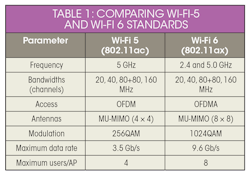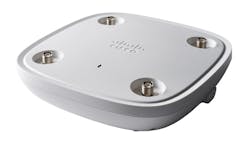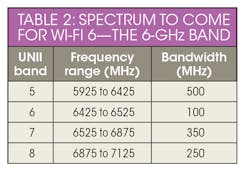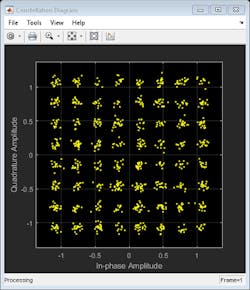Download this article in PDF format.
Wireless local-area networks provide internet access for many users in rapidly growing numbers in homes, offices, factories, and public places. The growth rate is so fast, in fact, that what had been the international standard for wireless networking, IEEE 802.11ac, released in 2014, can no longer keep up. It’s now being replaced by a new version of the standard, IEEE 802.11ax. In other words, IEEE 802.11ac is Wi-Fi 5 and IEEE 802.11ax is Wi-Fi 6. The standards are compatible but also different in many ways, with enough disparities to combine for significant improvements in wireless network capacity and efficiency for all users, even in crowded places (Table 1).
Wi-Fi 6 improves on the performance of Wi-Fi 5 by borrowing useful techniques from 4G Long Term Evolution (LTE) cellular radio technology, in the hopes that Wi-Fi 6 will provide the increased capacity needed for a growing number of interconnected wireless devices (Fig. 1). These range from Internet of Things (IoT) sensors and smarter 5G wireless cellular telephones to even connected cars.
1. Wi-Fi 6 is a wireless networking standard conceived and developed because of the rapidly growing worldwide reliance on wireless devices. (Courtesy of the Wi-Fi Alliance)
In addition to operating within narrow channel bandwidth at 2.4 GHz along with the 5-GHz spectrum already occupied by Wi-Fi 5 at 5 GHz, perhaps the biggest difference between the two Wi-Fi standards is the use of orthogonal frequency-division multiple access (OFDMA) in Wi-Fi 6 compared to orthogonal frequency-division multiplexing (OFDM) in Wi-Fi 5. OFDMA is essentially a multiple-user version of OFDM, making it possible to increase the capacity of a Wi-Fi 6 access point (AP) compared to a Wi-Fi 5 AP.
In both multiplexing formats, a wideband wireless carrier signal at a high data rate is divided into a large set of closely narrowband subcarriers at much lower data rates and then transmitted. To avoid interference between subcarriers, they are orthogonal to each other. The data is divided among all of the subcarriers whereby if any of the subcarriers is degraded or corrupted because of interference, the data can be restored by means of error-correction techniques. At the receiver, the subcarriers with their data contributions are combined to restore the initial high-speed transmission and its full data.
By using the orthogonal, low-data-rate subcarriers rather than the single high-data-rate carrier, the transmissions can minimize the effects of signal fading, multipath distortion, and interference from other signals within the same or nearby frequency spectrum. The low data rates of the subcarriers reduce the effects of intersymbol interference (ISI) that are typically more pronounced at higher data rates.
One drawback to OFDM is that a single user occupies each carrier with all its subcarriers at any one time. Multiple users are possible by means of static multiple-access schemes, such as having different transmission times per carrier/subcarriers for each user in a time-division-multiple-access (TDMA) scheme or different transmission frequencies in a frequency-division-multiple-access (FDMA) approach. However, these methods are not efficient in their use of time and/or frequency.
To develop a more efficient version of Wi-Fi 5, having multiple-user APs was an important consideration for Wi-Fi 6—in OFDMA, a single user does not occupy all of the subcarriers at any one time. For enhanced efficiency, the subcarriers are themselves divided among multiple users. Multiple users can access their assigned subcarriers by means of TDMA or FDMA, or both techniques simultaneously. APs use segments of frequency and time known as resource units (RUs) to manage multiple simultaneous users. Because the subcarriers are subdivided in this way, timing synchronization of the multiple Wi-Fi 6 users for a single AP is critical compared to Wi-Fi 5, adding to the complexity of transmitters, receivers, and APs (Fig. 2).
2. Wi-Fi 6 adds capacity by using access points that enable many simultaneous users. (Courtesy of Cisco Systems)
Timing is Everything
Since multiple users will connect to a Wi-Fi 6 AP simultaneously, timing across the different users must be precise to minimize interference among subcarriers. For Wi-Fi 6 wireless networks to achieve the highest capacity, it’s essential to minimize interference between simultaneous users.
Synchronization of multiple users is achieved by a trigger frame broadcast by the AP. The trigger frame contains information about when different users and devices can transmit and which subsets of OFDMA subcarriers’ RUs to use. The precise timing required among different users and within each AP emphasizes the importance of the reference-clock oscillators within Wi-Fi 6—they must have extremely low phase noise and low jitter with excellent long-term frequency stability.
For environments with obstructions or interference sources, using different subcarriers per user can be programmed by location to avoid the loss of data due to multipath or fading. In contrast to OFDM, in which all subcarriers are transmitted at the same power level, the subcarriers in ODFMA can be broadcast at different power levels. It’s an additional weapon against fading that might occur in part of the frequency spectrum in an operating environment. As with OFDM, in OFDMA, each user’s multiple low-data-rate subcarriers are combined at the receiver to form the high-speed data that was originally transmitted for access by that user.
An OFDMA AP can change the amount of frequency spectrum or subchannels occupied by each user depending on the demands of their wireless connections. For example, less bandwidth is needed to send an e-mail than to send streaming video to a Wi-Fi receiver. This functionality boosts the efficiency of Wi-Fi 6 compared to Wi-Fi 5, but also increases the complexity of the hardware in terms of frequency alignment, stability, and accuracy, timing synchronization, and response time of wireless-network system components.
Achieving Control of Power
Power control is needed in Wi-Fi 6 systems because of its OFDMA and due to multiple users with simultaneous access to the wireless network. A user close to the AP would present a higher-power signal to the AP than a user operating at the outer sensitivity limits of the AP. If the power levels of multiple users are not balanced, network performance will be compromised by intercarrier interference (ICI) and compression when a Wi-Fi receiver attempts to process multiple signals across a wide dynamic range. Wi-Fi 6 devices will increase or decrease their transmit power levels within a certain response time according to downlink signals from an AP.
This dynamic transmit power control (DTPC) feature of Wi-Fi 6 networks can, of course, be compromised by devices that ignore the power-control instructions in a downlink signal or because they simply lack the power-control capability (as with earlier-generation Wi-Fi devices). The amount of power control and how accurately power is controlled for each device is defined within the Wi-Fi 6 (802.11ax) standard. Devices with tight control of power, within ±3 dB, are considered Class A devices, while devices capable of ±9 dB control of power are referred to as Class B devices, somewhat in the manner of amplifier linearity classes.
Wi-Fi 6 includes several unique features to help boost capacity in dense environments, such as convention centers and other public meeting places, and save power for devices like IoT sensors that may only require occasional network access. Basic service set (BSS) coloring identifies shared frequency spectrum by a number or “color code” included within the network physical-layer (PHY) header that’s communicated between each device and its AP. BSS makes it possible for Wi-Fi 6 devices to communicate and negotiate with each other to optimize use of shared channel bandwidth. BSS coloring indicates when a channel is unavailable—when two or more devices are coded by the same color. It also provides information to manage multiple devices and users in congested areas by adjusting clear-channel-assessment (CCA) parameters, including dynamic range and power control.
Another unique feature of Wi-Fi 6—target wake time (TWT)—is a method for an AP to monitor device requirements and turn its Wi-Fi 6 radio on and off as needed. For example, one of the devices within range of a Wi-Fi 6 AP may be an IoT proximity sensor that does not require continuous radio contact with the network. The TWT feature can be used to periodically activate the IoT sensor. In working this way, the TWT function can improve network efficiency and conserve battery life in portable/mobile devices.
For multiple users in dense environments with a great many wireless devices, Wi-Fi 6 builds upon the multiple-user, multiple-input, multiple-output (MU-MIMO) antenna configurations used in Wi-Fi 5, with extended capabilities. Wi-Fi 5 routers, with their multiple antennas, are designed to handle as many as four simultaneous users or data streams. Large data transfers are possible, but only on downlinks from routers or APs to user devices.
In contrast, the MU-MIMO antenna arrangements of Wi-Fi 6 support as many as eight simultaneous spatial data streams for eight simultaneous users, without buffering delays, on both downlinks and uplinks between APs and wireless devices. As a result, Wi-Fi 6 wireless networks can handle large data transfers back and forth between wireless devices and APs without data buffer delays. Therefore, a greater number of users (than Wi-Fi 5) per AP can enjoy even data-intensive applications, such as video streaming, simultaneously.
Using the Bandwidth
Although Wi-Fi capacity and efficiency will be enhanced by OFDMA and MU-MIMO technologies, the number of users that can be supported per channel starts with available spectrum and channel bandwidth. While Wi-Fi 6 shares the frequency spectrum used by Wi-Fi 5 in the 5-GHz band, from 5.170 to 5.185 GHz with some small gaps, it also takes advantage of the legacy available frequency spectrum in the unlicensed 2.400- to 2.483-GHz portion of the industrial, scientific and medical (ISM) bands. With four spectral streams in the 2.4-GHz band and eight more possible in the 5-GHz range, and channel bandwidths of 20, 40, 80, and 160 MHz available (with wider-bandwidth channels supporting higher data rates), many more users can be supported with Wi-Fi 6 than the four spectral streams of Wi-Fi 5.
To add to the capacity of Wi-Fi 6, regulatory agencies such as the Federal Communications Commission (FCC) in the U.S. and European Telecommunications Standards Institute (ETSI) throughout Europe have approved the use of wide contiguous bandwidth in the 6-GHz range starting in 2022. The additional bandwidth is for use by Wi-Fi 6 devices and 5G cellular wireless networks, but not by earlier-generation Wi-Fi systems, such as Wi-Fi 4 (IEEE 802.11n) and Wi-Fi 5.
The 6-GHz band approved by the FCC for Wi-Fi 6 spans 1200 MHz from 5.925 to 7.125 GHz and is identified by Unlicensed National Information Infrastructure (UNII) radio-frequency bands 5 through 8 (Table 2). This generous portion of contiguous bandwidth at 6 GHz will make possible more wideband (160-MHz) channels for high-data-rate transmissions than at the lower-frequency 2.4- and 5-GHz bands, where the Wi-Fi channels tend to compete with more legacy applications and must operate within more narrowband channels.
To efficiently use the available bandwidth with enhanced data throughput, Wi-Fi 6 employs quadrature-amplitude-modulation (QAM) formats at levels as high as 1024-state QAM (1024QAM). This contrasts with the lower-order 256-state QAM (256QAM) of Wi-Fi 5. 1024QAM enables digital bit resolution of 10 bits per symbol in a constellation diagram (Fig. 3), for as much as 25% more data-handling capacity than the 8-bit-per-symbol resolution for 256QAM used with Wi-Fi 5.
3. 1024QAM is one of the features implemented in Wi-Fi 6 for increased data speed and capacity. This diagram shows a QAM constellation diagram with 64 symbols. (Courtesy of MathWorks)
On the downside, the 1024QAM data mapping that takes place at a Wi-Fi 6 transmitter, to achieve the conversion of digital bits to I/Q symbols, places great demands on the linearity of power amplifiers (PAs) used for transmissions in a 1024QAM system—more so than in 256QAM systems. If power amplification is not linear and the ratio of the energy per bit to the noise level (Eb/N0) is not properly controlled, data errors can be readily introduced into higher-order QAM systems such as 1024QAM.
Evolving to Meet Demand
Whether it’s called IEEE 802.11 or Wi-Fi, wireless networks have become an increasingly important part of many lives worldwide, whether in fixed environments such as homes or factories or in large public domains like convention centers, museums, or even in a sporting stadium. Demand for increased capacity and throughput speeds grows as users add more wireless devices to each network and expect faster response times as they download large files or even stream their favorite video programming.
Wi-Fi 6, the former IEEE 802.11ax, builds on the technology legacies of earlier Wi-Fi generations to maintain compatibility with older wireless devices at 2.4 GHz. Simultaneously, it provides increased capacity and enhanced data rates within the 5-GHz channels of newer Wi-Fi generations.
It’s a wireless standard that’s also poised for evolution, with special features to help save power when networking requirements are minimal or when hordes of new IoT sensors are added in range of a wireless network and must be periodically monitored for their contributions—without “breaking the bank” in power consumption.
And, for the large amounts of new data expected from the next generation of wireless cellular communications systems, namely 5G, Wi-Fi 6 promises something that no earlier Wi-Fi generation can offer: Access for growth into some of the new bandwidth being made available within the 6- to 7-GHz range. If used wisely, this combination of new features and bandwidth should make Wi-Fi 6 a capable companion technology for 5G for many years to come.






